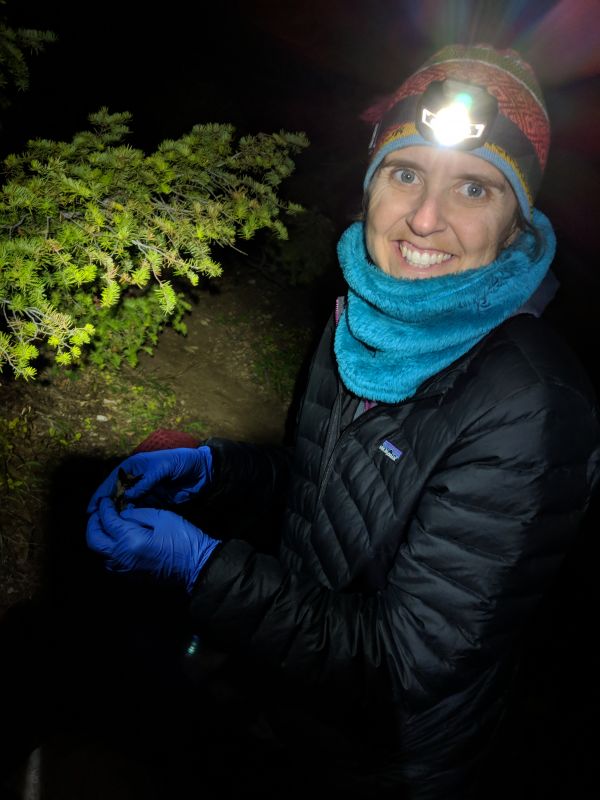This piece comes to us from the Wildlife Conservation Society (WCS). To honor Native American and First Peoples Heritage Month, WCS and Nature are sharing this story of nature and conservation.

Mertarvik Pioneer School, Mertarvik, Alaska, students (L-R): Fallyn Connelly, Murphy Fairbanks, Daisy and Glennesha Carl, getting to know more about bats and science from WCS Director of Health Research, Sarah Olson on Zoom. Photo courtesy Naomi Olson.
For over two decades, my cousin Naomi Olson has worked as a teacher in the remote Yup’ik village of Mertarvik, off the coast of western Alaska. In recent years she has invited me into her classroom, usually around Halloween, to talk to her high school students about bats. I’m a scientist with WCS (Wildlife Conservation Society), a global conservation organization, and bat research is a part of my job that I love.
Naomi’s lesson plan begins with her students reading a fictional short story, My Life as Bat, by Margaret Atwood, and I am her plug-in scientist that joins the class remotely on zoom. I look forward to it every year—on the one hand getting to share my global experience and excitement for bats from a biology perspective, and on the other hand, getting to learn about bats anew through the eyes of their generation and also their Yup’ik ways of knowing.
There are only five bat species found in Alaska, and of these, only the little-brown bat (Myotis lucifugus), ranges into Central and Interior Alaska, overlapping with traditional Yup’ik territory. A survey of villagers found 97% of roosts and all maternal colonies were found in human structures and also significantly expanded the known range of the bats, including Kotzebue.
Much further south in their Alaska range, little-brown bats hibernate in holes found in the ground, created within scree fields or within tree root structures. Though they are observed year-round, they are most sighted from July to September when they are busy putting on fat, which reaches 20% of their body mass by fall.

Dr. Sarah Olson sampling and releasing bats for research on white-nose syndrome in Montana. Photo credit: Sarah Olson/WCS.
This year, Naomi’s students shared some thank-you notes that included follow-up questions. In the spirit of Bat Week, here are a few excerpts and my responses:
‘I won’t forget when you told us about researching bats poop, and how you have to be careful when you do it. In our Yup’ik traditions language can have many different meanings. A bat in Yup’ik is called “unuiraq,” which means winged animals such as a hawks, eagles, seagulls, or even a bat. If an animal is unuiraq, you can’t eat it. Afterward, I was wondering if bats could understand us like dogs understand us. Or do we have to teach a bat to understand us like we teach dogs?’ – Daisy Carl
Bats as pets are not a good idea! However, when rescued bats are not able to return to the wild, they can be trained to eat mealworms and have been used as bat “ambassadors” to help the public better understand them. Some bats are also used in research, to learn more about flight for example, and some researchers also train bats to perform certain behaviors using food rewards, which is the same way we teach dogs.
‘Quyana (which means Thank you) for sharing some information on the mammal. We are all very thankful for them. I was wondering whether bats are the only mammals that can fly? What is the usual lifespan of bats? What kind of insects do bats usually eat? And what are the predators of bats?’ – Fallyn Connelly
Bats are the only mammal that can truly fly (flying squirrels are better described as gliders), and they typically live 10-20 years, which is an unusually long time for their size. There is a record of one bat in Siberia living to be 41 years old! The insects a bat eats will depend on the species but in North America they eat a lot of moths, water insects, and even mosquitoes, which are more like small snacks. As for predators, birds of prey like owls and hawks, snakes, and even small predators like raccoons will eat bats.
And the last question, from Glennesha Carl: “After your visit, I was wondering if bats are introverts.”
Now that’s something we can all ponder.
